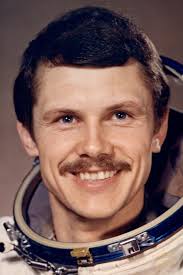Bertalan Farkas
Hungarian - (RFSA)
Retired
Date of Birth: Aug. 2, 1949
Age: 76
Bertalan Farkas (born August 2, 1949) is the first Hungarian cosmonaut and the first Esperantist in space. He is currently the president of Airlines Service and Trade. With Charles Simonyi's space travel, Farkas is no longer the only Hungarian who has been to space (he is still the only astronaut, as Simonyi flew as a space tourist).
Soyuz-U | Soyuz 35
Russian Federal Space Agency (ROSCOSMOS) | RussiaBaikonur Cosmodrome, Republic of Kazakhstan
April 9, 1980, 1:38 p.m.
Status: Success
Mission:
Soyuz 35 was the eighth mission to visit the Salyut 6 space station and carried the EO-4 expedition, which was the fourth long-duration crew for the station. The mission began on April 9, 1980, 13:38:22 UTC, launching Commander Leonid Popov and Research Cosmonaut/Flight Engineer Valery Ryumin into orbit. They docked with the station the next day. During their 186-day stay on the station, EO-4 crew conducted various scientific experiments, some repairs and replacements to the station and were visited by three uncrewed Progress cargo spacecrafts and 4 crewed Soyuz vehicles. Soyuz 35 swapped vehicles with the Soyuz 37 crew, which allowed for a longer stay in orbit. The mission concluded with a safe landing back on Earth on October 11, 1980, 09:49:57 UTC.
Low Earth OrbitSoyuz-U | Soyuz 36
Russian Federal Space Agency (ROSCOSMOS) | RussiaBaikonur Cosmodrome, Republic of Kazakhstan
May 26, 1980, 6:20 p.m.
Status: Success
Mission:
Soyuz 36 was the ninth mission to visit the Salyut 6 space station and carried the EP-5 crew, which visited the long-duration Soyuz 35 resident crew. The mission began on May 26, 1980, 18:20:39 UTC, launching Commander Valery Kubasov and Research Cosmonaut Bertalan Farkas, the first Hungarian cosmonaut, into orbit. They docked with the station the next day. During their 7-day stay on the station, EP-5 crew conducted various scientific experiments, including measuring radiation doses received by the crew. Soyuz 36 swapped vehicles with the resident station crew, and returned in Soyuz 35 spacecraft. The mission concluded with a safe landing back on Earth on June 3, 1980, 15:06 UTC.
Low Earth OrbitThe Roscosmos State Corporation for Space Activities, commonly known as Roscosmos, is the governmental body responsible for the space science program of the Russian Federation and general aerospace research. Soyuz has many launch locations the Russian sites are Baikonur, Plesetsk and Vostochny however Ariane also purchases the vehicle and launches it from French Guiana.
Soyuz 2.1a
Obzor-R No.1
43/4 (43R) - Plesetsk Cosmodrome, Russian FederationNote: Assignment of payloads to this launch is uncertain. The Russian Obzor-R satellite is a planned X-band radar earth observation satellite desi…
LVM-3 (GSLV Mk III)
BlueBird Block 2 #1
Satish Dhawan Space Centre Second Launch Pad - Satish Dhawan Space Centre, IndiaAST SpaceMobile’s Block 2 BlueBird satellites are designed to deliver up to 10 times the bandwidth capacity of the BlueBird Block 1 satellites, requi…
Long March 12A
Demo Flight
Long March 12A Pad - Jiuquan Satellite Launch Center, People's Republic of ChinaFirst test launch of CASC/SAST’s Long March 12A rocket, with a dummy payload. The rocket’s 1st stage attempted to land on a landing pad about 300 km …
HANBIT-Nano
Spaceward
HANBIT Pad - Alcântara Space Center, Federative Republic of BrazilMaiden orbital launch attempt for the South Korean start-up Innospace and its HANBIT-Nano small launch vehicle. Onboard this flight are five small sa…
H3-22
Michibiki 5 (QZS-5)
Yoshinobu Launch Complex LP-2 - Tanegashima Space Center, JapanQZSS (Quasi Zenith Satellite System) is a Japanese satellite navigation system operating from inclined, elliptical geosynchronous orbits to achieve o…



